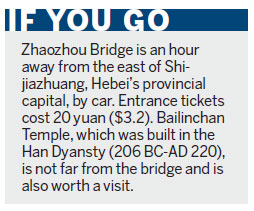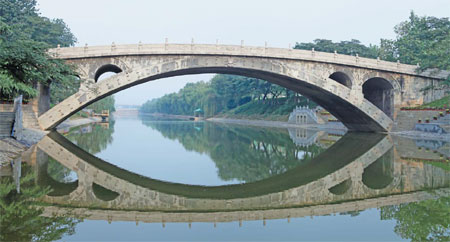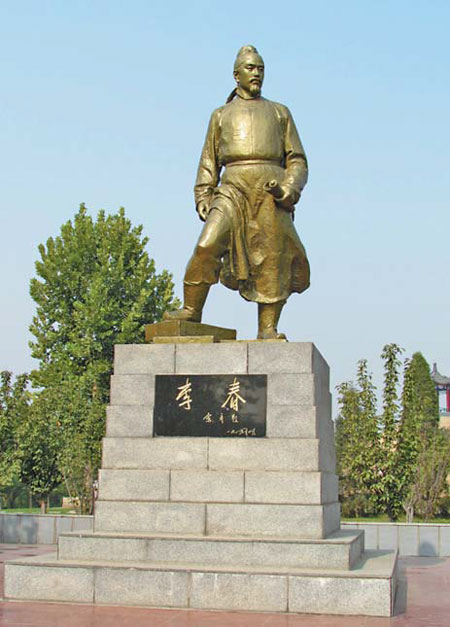Bridge still stands over troubled water
Updated: 2014-06-01 07:28
By Li Yang(China Daily)
|
|||||||
Legendary stone structure withstands the test of time. Li Yang reports in Hebei province.
At the start of the Sui Dynasty (AD 581-618), when the country was unified after 300 years of chaos, the Zhaoxian county of Hebei province was a key route that linked the north and south. However the crossroad was often blocked by the Jiaohe River, especially during flood season. So the idea to build a bridge across the water was born. The Zhaozhou Bridge, locally nicknamed Dashiqiao, "big stone bridge", is built between AD 605 and 618, and is now one of the oldest and most renowned stone arch bridges in the world.
Architect Li Chun designed the bridge and led its construction. The large stone bridge, which was reinforced nine times and survived wars, floods and earthquakes during the past 1,400 years, still stands today.
The bridge is renowned for its endurance and longevity but also its combination of practicality and aesthetics, which include some of the oldest examples of delicate structures.
The 50.82-meter-long bridge has a 37.02-meter main arch and rises 7.23 meters above the river. The bridge is relatively flat, which made it easier for horse carts to roll across.
Two smaller arches on either side of the main arch add an element of visual symmetry. The design also lightens the overall weight of the bridge by 700 metric tons and enlarges its discharge capacity by about 16 percent. The four small arches also reduce the water's impact on the bridge when floods submerge the structure.
"I could feel the bridge shaking under my feet with torrents of floodwater when I was young. But we have never worried about it collapsing because it has never gone wrong," says a local villager.
The central area of Hebei, where the bridge is located, is one of the most active earthquake zones in the world. In 1966, a 6.8-magnitude earthquake hit Xingtai, 40 kilometers from the bridge; and in 1976, a 7.8-magnitude earthquake hit Tangshan, which is 400 kilometers away. The old bridge survived both quakes due to its unique arch structure.
The 2,800-ton bridge is based on 1.56-meter-high stone platforms on either side of the riverbank. Modern architects were surprised to find the platforms were laid directly on rocks by the river, and in the past 1,400 years the platforms have only sunk about 5 centimeters. It remains a mystery how Li found a rock base that has sustained the heavy bridge for so long.
The bridge has an integrated structure and distributes its weight.
The bridge floor is 9 meters wide in the center of the bridge and expands out to 9.6 meters on either side where it meets the riverbank.
Li constructed 28 independent arch segments, which form the main arch of the bridge. The combined arches sustain weight and tension together so the bridge will not collapse if one segment of the arch breaks.
The design also makes it easy to repair the arch. If one segment is broken it can simply be replaced. The contact surfaces of the arch segments are covered with tiny patterns to enlarge frictional forces.

The segments of each arch were carefully crafted to be the same size and shape.
Five iron rods go through the 28 arch segments to hold them together and form the main spandrel arch. Dozens of dovetails tightly join the segments.
The four smaller arches are also held together with iron rods each and were made in the same way.
Guard slabs on either side of the bridge are engraved with delicate patterns of dragons, which are a symbol of water God in the Chinese culture.
The stone guard pillars on both sides of the bridge were sculpted to show lions in different poses.
Tablets next to the bridge include clear instructions on how to repair the structure. The local government built a small museum for these tablets.
The Jiaohe River was a busy waterway since the Sui Dynasty but was seriously polluted in the 1980s and 1990s. The river became a sewage ditch for Shijiazhuang, the capital city of Hebei province, until the local government built a new sewage system in 2012 and cleaned up the river.
Contact the writer at liyang@chinadaily.com.cn
|
Zhaozhou Bridge, a 1,400-year-old stone bridge that straddles the Jiaohe River in Zhaoxian county, Hebei province, is known for its longevity and combination of practicality and aesthetics. Zhu Tao / for China Daily |
|
A statue of designer Li Chun stands beside Zhaozhou Bridge. Bao Xinguo / China Daily |
(China Daily 06/01/2014 page10)

